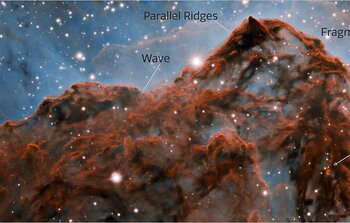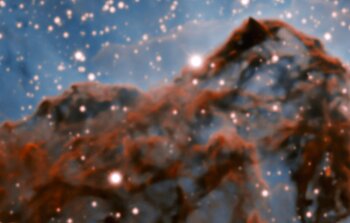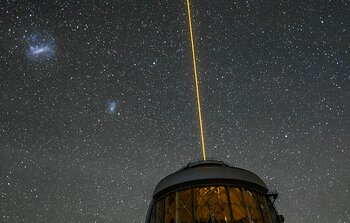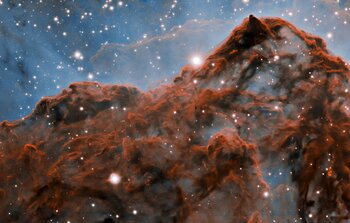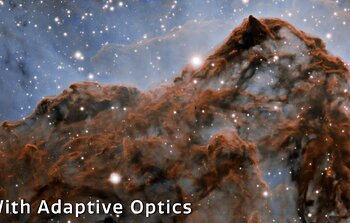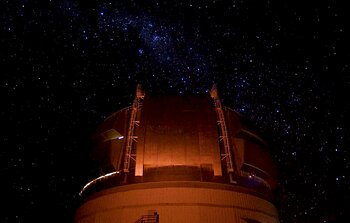Looking Sharp: Most Detailed Image Yet of Famous Stellar Nursery
October 5, 2020
The Carina Nebula observed in unprecedented detail with adaptive optics

Astronomers using the international Gemini Observatory, a Program of NSF NOIRLab, have captured the western wall of the Carina Nebula in unprecedented detail in a compelling image released today. The image reveals a number of unusual structures in the nebula. The exquisite detail revealed in the image is in part due to a technology known as adaptive optics, which resulted in a ten-fold improvement in the sharpness of the research team’s observations.
There is no better location to investigate the birth of stars than nebulae — regions of gas and dust where stars coalesce, heat up and start to glow. The brilliant Carina Nebula, located in the southern hemisphere sky, is 500 times larger in actual area than the better-known Orion Nebula, making it an ideal candidate for investigating star formation.
The team used adaptive optics on the 8.1-meter Gemini South telescope in Chile to significantly improve upon previous observations of the Carina Nebula’s western wall, the well-defined edge of the nebula. Adaptive optics compensates for the effects of turbulence in the Earth’s atmosphere to produce pin-sharp images, comparable to those from a space telescope. Indeed, this image is reminiscent of the famous Hubble Pillars of Creation in the Eagle Nebula.
Star-forming regions are shrouded in dust but it is possible to see through the shroud of dust by observing in infrared light. The team, led by Patrick Hartigan of Rice University, utilized the Gemini South Adaptive Optics Imager (GSAOI), a near-infrared adaptive optics camera, to peer through the outer layers of dust to reveal a huge wall of dust and gas glowing with the intense ultraviolet light from nearby massive young stars. This region is a great example of such a wall and this image provides a very clear view of a star-forming region in the near-infrared [1].
With a resolution ten times higher than it would be without adaptive optics from the ground [2], the image reveals a wealth of detail never observed before. This mountainous section of the nebula reveals a number of unusual structures. There is a long series of parallel ridges that could be produced by a magnetic field, a remarkable almost perfectly smooth wave, and fragments that appear to be in the process of being sheared off the cloud by a strong wind. There is also evidence for a jet of material ejected from a newly-formed star.
The image provides the sharpest view to date of how massive young stars affect their surroundings and influence how star and planet formation proceeds. “It is possible that the Sun formed in such an environment,” said Hartigan. “If so, radiation and winds from any nearby massive stars would have affected the masses and atmospheres of the Solar System’s outer planets.” Astronomers are just beginning to model how such stars affect the evolution of planetary systems.
This spectacular image is a wonderful demonstration of the effectiveness of adaptive optics. It is also the first time that this region has been observed using this technique, so every new detail is a fascinating first glimpse for astronomers and the general public alike, and gives a taste of what could be possible with the upcoming James Webb Space Telescope.
More Information
This research was presented in a paper published today in the Astrophysical Journal Letters.
The team is composed of Patrick Hartigan (Rice University), Turlough Downes (Dublin City University), Andrea Isella (Rice University).
NSF NOIRLab (National Optical-Infrared Astronomy Research Laboratory), the US center for ground-based optical-infrared astronomy, operates the international Gemini Observatory (a facility of NSF, NRC–Canada, ANID–Chile, MCTIC–Brazil, MINCyT–Argentina, and KASI–Republic of Korea), Kitt Peak National Observatory (KPNO), Cerro Tololo Inter-American Observatory (CTIO), the Community Science and Data Center (CSDC), and Vera C. Rubin Observatory (in cooperation with DOE’s SLAC National Accelerator Laboratory). It is managed by the Association of Universities for Research in Astronomy (AURA) under a cooperative agreement with NSF and is headquartered in Tucson, Arizona. The astronomical community is honored to have the opportunity to conduct astronomical research on Iolkam Du’ag (Kitt Peak) in Arizona, on Maunakea in Hawaiʻi, and on Cerro Tololo and Cerro Pachón in Chile. We recognize and acknowledge the very significant cultural role and reverence that these sites have to the Tohono O'odham Nation, to the Native Hawaiian community, and to the local communities in Chile, respectively.
Links
Contacts
Amanda Kocz
amanda.kocz@noirlab.edu
+1 520 318 8591
Press and Internal Communications Officer
NSF NOIRLab


